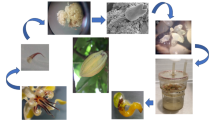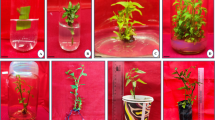Abstract
Internode explants of in vitro plants of Forsythia×intermedia "Spring Glory" were transformed with the gus and npt II genes after inoculation with the A. tumefaciens strain EHA 101 harbouring the plasmid pFAJ3000. Shoot organogenesis took place from callused edges of explants. The first transformed buds were detected 4 to 6 weeks after transfer on regeneration medium, containing 25 mg/l kanamycin as selective agent. An averge of 1% of explants regenerated transgenic shoots.
β-glucuronidase assays and culture on kanamycin-containing medium provided the first indication of integration and expression of introduced genes in transformants. Southern blot and polymerase chain reaction amplification analyses gave molecular confirmation of genetic transformation. Transgenic plants were acclimatized in the greenhouse. Enzymatic assays on several organs of mature plants still showed β-glucuronidase activity, thus confirming stable integration of T-DNA in the plant genome.
Similar content being viewed by others
Author information
Authors and Affiliations
Additional information
Received 25 September 1995/Revised version received 23 April 1996 – Communicated by G. Pelletier
Rights and permissions
About this article
Cite this article
Rosati, C., Cadic, A., Renou, JP. et al. Regeneration and Agrobacterium-mediated transformation of Forsythia×intermedia "Spring Glory". Plant Cell Reports 16, 114–117 (1996). https://doi.org/10.1007/s002990050189
Issue Date:
DOI: https://doi.org/10.1007/s002990050189




